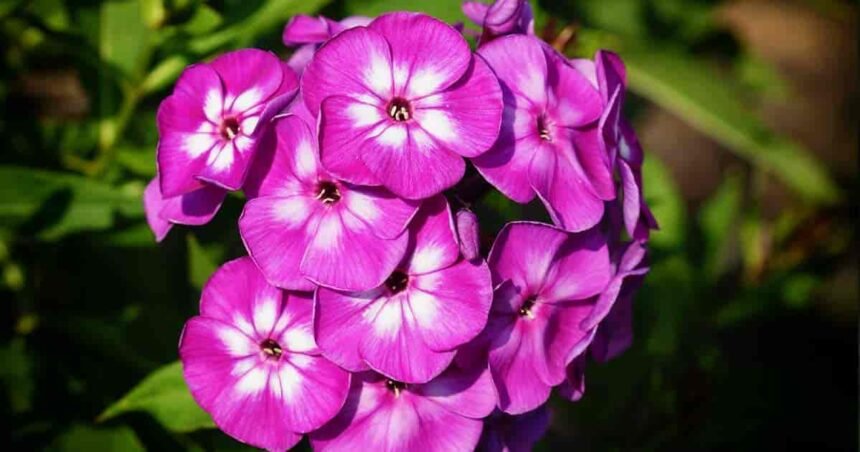Introduction
Phlox, a genus that encompasses a wide variety of flowering plants, is cherished by gardeners for its vibrant colors, delightful fragrance, and versatility in the landscape. Whether you’re looking to add a pop of color to a rock garden, fill a woodland space, or create a stunning perennial border, It offers options for every gardening need. In this comprehensive guide, we will explore everything you need to know about growing, caring for, and enjoying your garden.
Understanding Phlox: A Brief Overview
It belongs to the Polemoniaceae family and is native to North America. The genus includes over 60 species, ranging from low-growing ground covers to tall, striking perennials. The flowers are typically star-shaped, forming clusters that can cover the plant in a vibrant blanket of color. Its blooms are available in a wide range of colors, including pink, red, purple, blue, and white, making them a versatile choice for gardeners seeking to create a visually dynamic landscape.
Types of Phlox: Choosing the Right Variety for Your Garden
Phlox species vary greatly in terms of growth habit, blooming period, and preferred growing conditions. Understanding these differences is key to selecting the right one for your garden.
Creeping Phlox (Phlox subulata):
This low-growing variety forms a dense mat of foliage, making it an excellent ground cover. Creeping It is often used in rock gardens, along pathways, or on slopes to prevent soil erosion. It blooms in early spring, producing a carpet of small, star-shaped flowers in shades of pink, purple, white, and blue.
Tall Garden Phlox (Phlox paniculata):
Known for its tall stature and fragrant blobloomse s, garthe den is a standout in perennial borders. It can reach heights of up to four feet and produces large clusters of flowers from mid-summer to early fall. This species is particularly popular for attracting butterflies and hummingbirds to the garden.
Woodland Phlox (Phlox divaricata):
Woodland is a shade-loving species that blooms in early spring. Its delicate, fragrant flowers come in shades of blue, lavender, and white, and are ideal for planting under trees or in shaded areas of the garden. This variety is perfect for creating a serene, naturalistic woodland garden.
Annual Phlox (Phlox drummondii):
Unlike other species, which are perennials, Its drummondii is an annual. It is commonly grown in garden beds, borders, and containers for its bright, colorful blooms that last throughout the summer. This variety is particularly useful for adding a splash of color to garden spaces where other plants have finished blooming.
Growing Phlox: Best Practices for Success
Growing successfully requires an understanding of its preferred growing conditions. While phlox is generally easy to grow, paying attention to soil, light, and water needs will ensure your plants thrive.
Soil Requirements:
It prefers well-drained soil that is rich in organic matter. For the best results, prepare your planting area by incorporating compost or aged manure into the soil. This will improve soil structure, enhance fertility, and ensure good drainage. While phlox can tolerate a range of soil pH levels, it performs best in slightly acidic to neutral soil (pH 6.0 to 7.0).
Sunlight Needs:
The sunlight requirements for vary depending on the species. Garden and creeping phlox thrive in full sun, needing at least six hours of direct sunlight per day to produce abundant blooms. Woodland phlox, on the other hand, prefers partial shade and is well-suited to areas with dappled sunlight or morning sun and afternoon shade.
Watering:
plants need consistent moisture, especially during the first year after planting. Water your phlox regularly to keep the soil evenly moist, but avoid waterlogged conditions, as this can lead to root rot. A layer of mulch around the base of the plants will help retain moisture, suppress weeds, and regulate soil temperature.
Fertilization:
it benefits from regular feeding during the growing season. Apply a balanced, slow-release fertilizer in the spring when new growth begins, and again in mid-summer to support continued blooming. Alternatively, you can feed your plants with a liquid fertilizer every four to six weeks throughout the growing season.
Phlox in Garden Design: How to Incorporate These Vibrant Blooms
Phlox’s versatility makes it an excellent choice for various garden settings. Here are some design ideas for incorporating into your landscape:
Perennial Borders:
Tall garden is ideal for the middle or back of perennial borders, where its height and bold colors can create a striking focal point. Pair it with other sun-loving perennials like coneflowers, rudbeckia, and daylilies to create a long-lasting display of color.
Ground Covers:
Creeping phlox is perfect for filling in gaps between rocks in a rock garden or covering bare patches on slopes. Its low-growing habit and dense foliage provide excellent ground coverage, while its early spring blooms add a burst of color when few other plants are in flower.
Woodland Gardens:
Woodland is a natural choice for shaded areas, where it can create a carpet of delicate blooms under trees or along shaded pathways. Combine it with ferns, hostas, and other shade-tolerant plants for a lush, green tapestry punctuated by splashes of color.
d. Container Gardens:
Annual phlox is well-suited to container gardens, where its vibrant colors can be enjoyed up close. Use as a centerpiece in mixed containers, or plant it en masse for a bold, colorful display on patios, balconies, or porches.
Caring for Phlox: Tips for Healthy Plants and Abundant Blooms
Phlox is relatively low-maintenance, but a few key care practices will keep your plants healthy and blooming:
a. Deadheading:
Regularly remove spent blooms to encourage continued flowering and prevent the plant from self-seeding. Deadheading also helps maintain a tidy appearance and prolongs the blooming period.
b. Dividing:
Perennial phlox species, especially garden phlox, benefit from division every few years. Dividing the plants prevents overcrowding, improves air circulation, and rejuvenates the plants, resulting in more vigorous growth and flowering. The best time to divide phlox is in early spring or early fall.
c. Pest and Disease Management:
Phlox can be susceptible to pests like spider mites and diseases like powdery mildew. To reduce the risk of powdery mildew, ensure good air circulation around the plants by spacing them properly and avoiding overhead watering. If mildew does develop, treat it with a fungicide or remove and destroy affected plant material. Regularly inspect your plants for pests and treat infestations promptly with insecticidal soap or neem oil.
Ecological Benefits of Growing Phlox
Phlox not only enhances your garden’s aesthetic appeal but also provides important ecological benefits:
Attracting Pollinators:
Phlox flowers are rich in nectar and attract a variety of pollinators, including bees, butterflies, and hummingbirds. By planting phlox, you’re supporting local pollinator populations and contributing to the health of your garden ecosystem.
Erosion Control:
Creeping phlox is particularly useful for preventing soil erosion on slopes and hillsides. Its dense root system stabilizes the soil, reducing the risk of erosion and runoff.

Popular Phlox Varieties to Try in Your Garden
Here are a few popular phlox varieties to consider adding to your garden:
‘Bright Eyes’ (Phlox paniculata):
This garden phlox variety features light pink flowers with a darker pink eye. It’s a compact variety that reaches about three feet in height and is resistant to powdery mildew.
‘Candy Stripe’ (Phlox subulata):
A creeping phlox variety, ‘Candy Stripe’ is known for its striking white flowers with pink edges. It’s an excellent choice for adding a splash of color to rock gardens or as a ground cover.
‘Blue Paradise’ (Phlox paniculata):
This variety of garden phlox offers beautiful blue flowers that deepen in color as the day progresses. It’s a tall, upright plant that looks stunning in the back of borders or cottage gardens.
Conclusion
Phlox is a versatile and rewarding plant that can bring color, fragrance, and ecological benefits to your garden. Whether you choose to grow tall garden phlox in a sunny border, creeping phlox in a rock garden, or woodland phlox in a shaded corner, these beautiful plants are sure to enhance your outdoor space. By following the tips outlined in this guide, you can enjoy healthy, vibrant phlox blooms year after year, making them a cherished part of your garden landscape.







